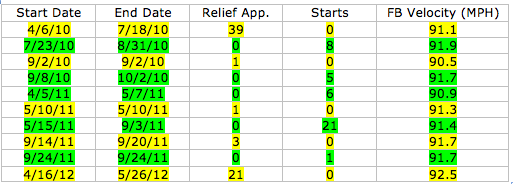The Case for Brian Duensing, Starting Pitcher
 Sam Waters |
Sam Waters |  Wednesday, May 30, 2012 at 3:16PM
Wednesday, May 30, 2012 at 3:16PM
Brian Duensing has seen action in the Twins’ starting rotation during parts of the last three seasons with moderate success, but this year he has worked exclusively out of the bullpen. Brian Duensing is merely an average pitcher, so this would not be all that noteworthy or surprising if the Twins already had five capable starting pitchers. The Twins, however, do not have five capable starting pitchers. Scott Diamond, by no means an ace himself, is their only starter with a SIERA under four. Despite their lack of options, the Twins seem determined not to give Duensing a shot in the rotation. The following pitchers have started games for the Twins: Diamond, Carl Pavano, Nick Blackburn, Jason Marquis, Francisco Liriano, P.J. Walters, Anthony Swarzak, Liam Hendriks, and Cole DeVries. It seems strange that the Twins would go through this entire laundry list of mediocrity while ignoring a more solid option like Duensing.
Of course, with the Twins mired in last place you might ask if it really matters at this point. I’m not bringing this up so that I can complain about the management decisions of a downtrodden franchise, but to highlight a player underappreciated by his own team who could represent a good buying opportunity for a contending club in need of a fifth starter. Let’s take a look at why the Twins appear to be making a mistake keeping Duensing in the bullpen, and what he could provide as a starter for the Twins or a potential trade partner.
On the surface, Duensing appears to be better as a reliever, with a career ERA of 3.22 out of the bullpen and a career ERA of 4.15 as a starter. His peripheral stats though, indicate that he is really as good, if not better as a starter.

His superior strikeout and walk rates along with a near-constant ground ball rate and a 4.04 xFIP as a starter point to Duensing actually being more effective in that role.
One of the other main reasons that the Twins might reject Duensing’s rotation candidacy, aside from a deceptive ERA, is his platoon split. Duensing is much more effective against lefties than righties, with an xFIP of 4.65 versus righties and an xFIP of 3.14 against lefties. But if Duensing already had to deal with this same platoon split in almost 300 innings as a starter to this point in his career, and was still able to put up a 4.04 xFIP, it clearly wasn’t a crippling problem. In other words, when we see that Duensing’s results are about average, these results already factor in the platoon split- if he was as good against righties as he is lefties, his past results would actually be well above average. Since the platoon penalty is already built in, there is no need to penalize him further for it. Yet still more potential issues need to be examined before declaring Duensing fit for the rotation.
A look at Duensing’s fastball velocity and performance by inning, however, further assures us of his viability as a starter. While most pitchers lose velocity when converting from starter to reliever, Duensing’s average fastball velocity has remained fairly stable as the Twins have haphazardly shifted him back and forth from the rotation to the bullpen. The chart below shows several different period spanning the last three seasons with the corresponding average fastball velocity of each in MPH. Periods spent as a reliever are highlighted in yellow and periods spent as a starter are highlighted in green:

We can see here that Duensing is preserving the life on his fastball as a starter in comparison to his fastball in relief, which is rather uncommon. (Daniel Bard, covered yesterday, happens to have lost about 4 MPH in his conversion to the rotation.) The next issue that could preclude Duensing from starting is a tendency to wear down deeper into games, so let’s move on to that possibility.
In fifty career starts, Duensing averages 5.89 innings pitched. Not an elite number, but not out of the ordinary. If he could get better luck on balls in play than in the past, that number could even go up. Duensing also appears capable of holding it together as he pitches deeper into his starts. Here we have his splits by inning as a starter in 2011:

Duensing’s strikeout and home run rates are about the same in the fifth and sixth innings as they are in the first four, while his walk rate is actually much better. He seems to have proven capable of maintaining his effectiveness when pitching multiple consecutive innings.
It appears that Brian Duensing has a strong case to return to the rotation. He is certainly capable of pitching multiple innings and has shown the ability to maintain his strikeout and walk rates and sustain his fastball velocity as a starter. So if he is basically the same pitcher in both roles, and he could provide more innings of the same quality as a starter, he would surely be more valuable in the rotation. After posting a 4.22 SIERA in over 400 career innings, it would not be surprising to see Duensing post a low-fours ERA if given the opportunity to start. Plenty of contending teams lacking pitching depth could use a pitcher of that caliber. Two players that happened to be covered on this site yesterday, Ubaldo Jiminez and Daniel Bard, could be great candidates for replacement down the line if they continue to founder for their respective teams. Rather than depleting their farm systems in a trade for a name arm, teams like the Indians and Red Sox could acquire Duensing for relatively little and get a solid back-of-the-rotation pitcher from a team that clearly undervalues him.
